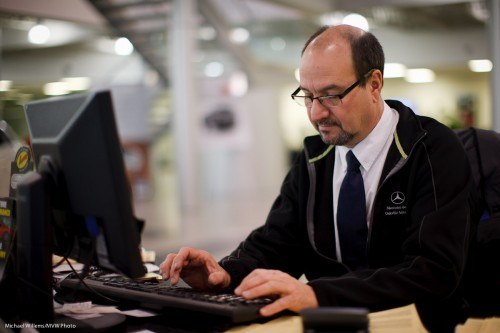Today I would once again like to chat for a moment about using prime lenses. This is a regularly recurring theme here at Speedlighter, because primes are beneficial in many ways.
A prime lens is a lens that does not zoom in or out. It is fixed. Like a 35mm lens, or a 50mm lens, rather than a 17-55 or 70-2oo zoom lens.
So that is a drawback, right? Zooming is more convenient than walking back and forth or than changing lenses all the time.
But prime lenses have many benefits, three of which are pretty well-known.
- They are usually sharper than zoom lenses, and often have less distortion around the edges.
- They are usually faster (wider aperture,lower “f-number”), meaning blurrier backgrounds and better low-light performance.
- They are often smaller and lighter than zoom lenses.
There are, however, three other benefits, and these may surprise you.
- They enforce consistency in a shoot. You do not have a different look and feel for every image!
- “Work it out once during a shoot, you have worked it out for all other shots too”. When you zoom, each shot works differently. Use a prime, this is more predictable. Hands up everyone who likes “predictable”?
- Primes really teach you about depth of field, shutter speed, and how these work together. Using a zoom lens it can be very difficult to get a grip on how all these factors work together. Using a prime, you get to really understand how aperture, depth-of-field, distance, ISO, and shutter all work harmoniously together – an understanding every photographer needs.
This is why I shoot with 50mm and 35mm prime lenses as often as I can.
If you can, get yourself at least a 50mm prime lens.
(Note that the examples here were shot on a full-frame camera, so 50 means 50. If you had a crop camera, like a Digital Rebel or a D90, you would want to use 24mm and 35mm lenses where I use 35mm and 50mm lenses.)





Totally agree! I just got through shooting one of my conferences using only my 5K Mk II and 50mm f/1.4. It made everything so easy… and a small benefit is that the camera weighed less, and was smaller to pack.
Also, I could hand the camera (pre-set) to someone else and have them run around taking pictures when I was busy, with one fewer thing to worry about.
Hi Michael,
Going through some of your older blogs and came across this post hoping to get some advice.
I have been thinking about getting a second lens for my Rebel series camera and am torn between primes and zooms. Specifically, I was looking at the EF-S 17-55 f.28 zoom vs getting both the 24mm f2.8 and 35mm f2.0 primes. I already own the 50mm f1.4.
Assuming that cost is not a factor, could you give me your thoughts? From my readings in your event photography shoots, you typically use a zoom as a walkaround and swap for a faster lens as needed.
Considering the 24 and 35 primes that I’m looking at are no faster/slightly faster than the zoom lens, would it make sense still to get the zoom lens? The only thing I think the zoom has in benefit over the primes is the versatility of less lens swapping. From reading my reviews (maybe you have your own reviews from experience as well) the build and picture quality between the 3 are not that far off from each other.
Your input is appreciated!
Leaman
I;d say – Prime if you possibly can. Leaman. And zoom when you must. “Slightly faster” – yes but a whole stop is not just “slightly”. I’ll answer more on tomorrow’s blog?
Thank you Michael.
I look forward to it!
Good to know the reason.,especially for beginner
but i think no need to debate which is better.
prime has its advantage, so is zoom.
Hi Michael, I was searching your blog for info on the 50mm prime lens (Im using it w/ a Rebel.. so I guess its not really a ‘true 50mm’ then.. ). Anyways, I like the lens but I will admit that I find it can be difficult to get it to focus. Sometimes it seems like it simply won’t, unless I move. Do you have any tips on this/can you explain why this happens and what I can do to make sure that I can focus and don’t end up ‘missing a shot’ because of it?